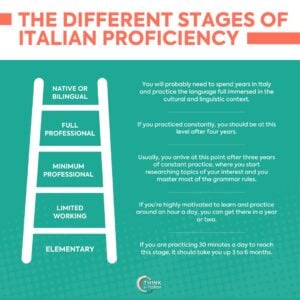What are regular Italian verbs?
There are many irregular verbs in the Italian language, including the auxiliary verbs essere and avere. They are called irregular because the endings in some tenses do not follow a consistent pattern.
However, Italian has a large number of regular verbs which follow a consistent format and a regular pattern.
What are the 3 Italian verb families?
Italian verbs are divided into three families depending on their endings as conjugations: verbs in -are (first conjugation), -ere (second conjugation), and -ire (third conjugation).
Common verbs such as mangiare (to eat), credere (to believe), and partire (to go) can be good instances of regular verbs in Italian.
The endings of the three conjugations for regular Italian verbs in the present indicative, imperfect indicative, remote past, and simple future are shown in the tables below.
Present Indicative
Of course, the presente is the tense of today or now. It means I eat or I am eating in English.
These are the present indicative’s endings:
| –are | –ere | –ire | |
| io | –o | –o | –o/–isco |
| tu | –i | –i | –i/–isci |
| lui, lei, lei | –a | –e | –e/–isce |
| noi | –iamo | –iamo | –iamo |
| voi | –ate | –ete | –ite |
| loro | –ano | –ono | –ono/–iscono |
Imperfect
The imperfetto is a past tense used to describe events and actions that occur repeatedly in the past.
The Italian imperfetto can be seen in phrases like “We used to meet at the bar every Friday.”
Regular verbs in all three conjugations have the following endings for this tense:
| –are | –ere | –ire | ||
| io | –avo | –evo | –ivo | |
| tu | –avi | –evi | –ivi | |
| lui, lei, Lei | –ava | –eva | –iva | |
| noi | –avamo | –evamo | –ivamo | |
| voi | –avate | –evate | –ivate | |
| loro | –avano | –evano | –ivano | |
Remote past tense
The regular verbs endings in the three conjugations for the remote past tense (passato remoto) are listed below.
| –are | –ere | –ire | |
| io | –ai | –ei/–etti | –ii |
| tu | –asti | –esti | –isti |
| lui, lei, Lei | –ò | –é/–ette | –ì |
| noi | –ammo | –emmo | –immo |
| voi | –aste | –este | –iste |
| loro | –arono | –erono/–ettero | –irono |
Simple future
Below are the endings for the three conjugations in the simple future time (futuro semplice).
| –are | –ere | –ire | |
| io | –erò | –erò | –irò |
| tu | –erai | –erai | –irai |
| lui, lei, Lei | –erà | –erà | –irà |
| noi | –eremo | –eremo | –iremo |
| voi | –erete | –erete | –irete |
| loro | –eranno | –eranno | –iranno |
Practice with Quizlet
Here's a set of flashcards and quizzes to practice this grammar topic.Regular verbs in Italian: key points
As you can see, since they all follow the same grammatical rules, there is nothing difficult about regular Italian verbs.
And once you have mastered the regular verbs, move on to the Italian irregular verbs and remember:
La pratica rende perfetti.
Practice makes perfect.




















One Response
Thanks for sharing this! It’s always helpful to learn about the different verb families in Italian.